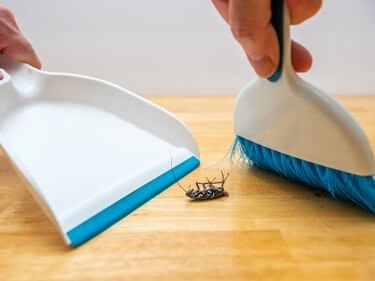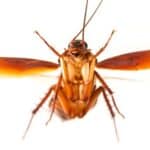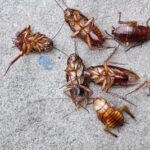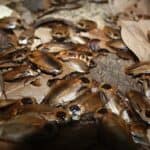When you see a lone cockroach in the house or somewhere else it shouldn’t be, it’s easy to fear that there are more lurking in the shadows. A cockroach infestation can be unpleasant, especially for people who are scared of cockroaches or associate them with uncleanliness. Is a single roach an indication that there are more you haven’t discovered yet?
It’s rare to find a lone cockroach. Cockroaches usually live in large colonies and reproduce quickly. A female cockroach and her offspring can produce up to 300,000 cockroaches per year. However, single roaches can be brought into a building through wood, packaging, furniture, and other materials. It’s essential to deal with a roach infestation as soon as you realize you have one.
If you do see a cockroach, remain calm. However, you need to bear in mind that the chances that more are nearby is relatively high. While that might be the case, rest assured that you can take steps to get rid of them.
Is One Roach A Sign of Infestation?
One cockroach may be a harmless loner. Seeing just one roach is not necessarily a sign that an infestation has taken hold within your environment. For example, the cockroach in question might be the last of its colony. Or it might be a wood roach brought in through a plank of firewood. It might even be a solo cockroach seeking food.
However, roaches reproduce at an alarmingly fast rate and rarely live alone. A female cockroach carries its egg case on its abdomen. This usually contains 30 to 40 eggs. The cockroach will carry the egg case until the eggs inside are ready to hatch. Once the baby roaches hatch, bright and white nymphs will quickly grow and continue the cycle.
A female roach can produce between 200 to 300 offspring throughout her lifetime. Although, amazingly, one female roach and her offspring could produce up to 300,000 roaches annually. If a cockroach infestation is left to develop, it can become a serious problem and almost impossible to treat as reproduction continuously occurs.
There are human physical and mental health issues to consider, too. According to a journal published on Springer Link, cockroach infestations can be a prime manifestation of diminished housing quality. And worryingly, recent findings discovered that individuals that live in homes with a cockroach infestation were almost 3 times more likely to experience the symptoms of depression than those without an infestation.
Are There More Cockroaches in Your Home?
If you spot a cockroach, you need to find out whether there are more. Cockroaches hide very well and tuck themselves away from humans when they are nearby. They’re also nocturnal creatures, so they tend to come alive at night when no one else is around. While difficult to find, the following are giveaway signs that cockroaches are nearby:
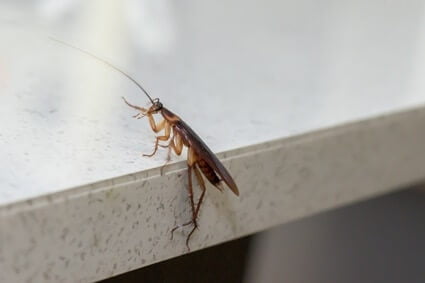
Hiding Spots
To find a roach infestation, you’ll need to discover their hiding spots. These are most likely to be dark places that are hard to reach. They also live close to food and water sources. The kitchen is usually a great place to start with your search, although roaches can also be found in toilets and bathrooms, especially where leakages occur.
Pay particular attention to the areas around the back of cabinets, behind the refrigerator, or around the trash can. Roaches may also appear around leaking bathroom pipes. Unfortunately, cockroaches can squeeze through tiny holes and floor gaps, making them difficult to find and catch.
Feces
Another key sign of a cockroach infestation is roach droppings. They look like small black specks, much like ground coffee or tiny peppercorn grinds. A large quantity of roach feces indicates that multiple pests are present. If you find droppings in numerous areas around the house, you might have a couple of colonies spread across different rooms.
Body Parts
If you have a roach infestation, you’ll likely find roach body parts as they live and grow. Many shed their exoskeleton in full, while others die. In which case, you’ll find the body intact. However, as cockroaches feed off the dead bodies, bits will be left behind. This includes wings, legs, and antennae. They’re not always easy to spot, but you’ll see them upon close inspection.
Cockroach Eggs
You’ll sometimes see egg cases around the home, which is a clear sign that reproduction has happened. Egg cases are brown or reddish and around ¼ inches long. However, they’re often hard to find as cockroaches hide them in cracks and tight spaces for the offsprings’ protection. Some cockroaches also stick them to the walls to keep them safe.
Bad Smells
Over time, a cockroach infestation can begin to smell oily or musty. This is because some species secrete to communicate. Cockroaches also release fatty acids as they die and decompose. This foul smell repels other cockroaches and insects.
It’s easy to mistake this for damp or regular household smells, so it often goes ignored. But a foul odor can indicate that cockroaches have been in the home for some time. It’s also an indication that an entire colony has rooted itself within your environment. Following the smell can lead you to their hiding places.
Poor Health
Cockroaches can trigger allergies and asthma attacks, but they can also make humans inside the home ill.
Cockroaches are found everywhere, including hospitals, and possess nocturnal and omnivorous features. Because of this, they’re ideal carriers of pathogenic microorganisms, including bacteria, protozoa, helminths, fungus, and viruses.
The bacteria they carry cause dysentery, cholera, typhoid, polio, and e-coli. These diseases are spread through vomit, saliva, and feces. If a cockroach consumes contaminated food, it will pass through its digestive system without the roach coming to harm. But if a human comes into direct contact with a roach, these diseases can instead be passed on.
Cockroaches can also pick up bacteria and pathogens through their legs, which they can pass on to the animals and objects they walk over. Therefore, if you start to experience illness symptoms, such as sickness, diarrhea, or allergies, cockroaches might be to blame.
Surface Smears
Cockroaches can leave brown smear marks on surfaces where water is present. These marks are more likely to appear in the kitchen or bathroom. If these marks keep appearing without reason and you can’t get rid of them, no matter how much you clean, check for cockroaches.
What to Do If You See A Single Cockroach?
If you determine that you’ve got a cockroach infestation, you must get it under control before it becomes a more significant issue. Fortunately, there is plenty you can do to eradicate the infestation and prevent cockroaches from coming back.
Although there are over 4,000 species of roaches globally, there are two main types found in an American household. These are German cockroaches and American cockroaches. However, once any cockroach gets into the home, they will remain for as long as they can, provided they can find food and shelter. To eradicate an infestation, follow these steps:
Cut Off the Food Supply
Cockroaches survive and thrive when food sources are available. Cockroaches aren’t fussy eaters; the US National Library of Medicine describes them as foragers. As well as regulating how much they eat, foragers can eat from different nutritionally imbalanced foods to consume an optimal nutrient blend.
Unopened food, debris, and crumbs will attract cockroaches. Therefore, it’s a good idea to clean up food wherever possible. Put everything away in cupboards, airtight containers, or the refrigerator. Check behind the back of cabinets for food, like bread or cereal, that might have fallen down the back. Roaches will use these forgotten foods as sustenance, even after they have gone past their use-by date.
Clean up dirty dishes, as these can be a haven for cockroaches. And every so often, deep clean the fridge inside and at the back for any juice or gunk that may have spilled. These food and drink remnants might not be visible to the human eye but will attract cockroaches.
Ensure your garbage can is safely stored and cleaned regularly with bleach. And use trash can bags that can be securely tied so that roaches can’t get in and out. This will prevent the creatures from finding food sources that make your home attractive.
Remove Hiding Spaces
Cockroaches hide to keep themselves safe. They will use any materials they find to do so, including paper and cardboard boxes. That’s why you’ll often find a cockroach scurry along after lifting off some rubbish from the floor. To prevent this, clean up trash regularly and recycle wherever possible. Leaving it to fester on the ground will only encourage cockroaches to make themselves home.
If you have cracks and gaps around the home, fill them in as effectively as possible to stop the roaches from using them as hiding spaces. Making it as hard as possible to set up a home will leave them feeling vulnerable.
Repel the Pests
Sanitation is the most effective way of repelling cockroaches. Creating a clean and sterile environment where food sources or hiding spaces are eliminated will help prevent a roach infestation. However, you will still need to do extra work to move the infestation completely.
Use sticky traps that attract cockroaches and lock them inside. This is a more environmentally friendly way to remove pests than by using pesticides in large areas. Essential oils are also effective at repelling roaches. Dab a couple of drops of lemon, eucalyptus, or lavender oil around the home to keep them away.
You can create a homemade repellent using white vinegar and water. If you have a steamer, place the solution inside and clean the home from top to toe. Cockroaches won’t be able to stand the smell and will find somewhere else to colonize.
Insecticides with a diatomaceous earth base are effective at chasing cockroaches away. These insecticides come in a non-toxic powder form that can be placed behind cupboards and baseboards.
Remove Entry Points
Cockroaches can flatten themselves to fit through the smallest gaps and cracks. It’s hard to manage where cockroaches are coming in and out from, so it’s essential to try to fill in as many holes as possible, inside and out.
Use door guards, clear caulk, or steel wool to seal gaps. Also, try to look for any cracks of light because these gaps are accessible to pests, especially cockroaches, who can flatten their bodies. You might have to wait until night-time for this when you can turn the lights on to check for holes and cracks.
When you bring wood or anything paper material into the home, check for any pests first, in case cockroaches have been hiding amongst them. This can bring roaches into the house that are then difficult to get rid of.
How Do Cockroaches Travel?
If you experience a cockroach infestation, you might be wondering how the pests even got there in the first place. The most common misconception is that cockroaches only infest dirty houses. But even the cleanest homes are at risk of these pests.
If you’ve recently moved into a house, cockroaches might have been there long before you arrived. Cockroaches can also be easily transported from one place to another and can sneak into cardboard boxes during the move.
But it’s not just when moving to a new house that you have to be careful. German or brown-banded cockroaches can be found in grocery bags or cardboard boxes, so always check containers or food before you put them away. Dispose of all packaging to avoid cockroaches getting loose.
Cockroaches can also get into the home through plumbing and pipes. Some pests can get into apartments by scaling the plumbing within the shared wall. Similarly, Oriental cockroaches use plumbing pipes to enter buildings from their outside habits. They can also get in through gaps in the floor and under doors.
Other entry points include sewers and drains. To prevent cockroaches from getting in, seal holes in common walls and gaps around pipes. Also, make sure all doors and windows are closed where possible.
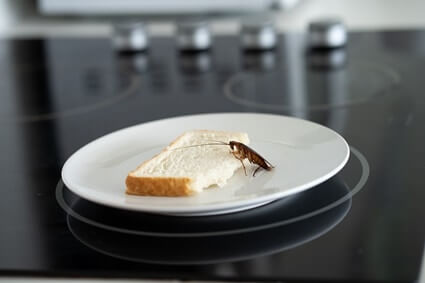
Types of Cockroach Found in Homes
There are 4,600 known species of cockroaches in the world. However, only 30 of them have adapted to live alongside humans – 5 of which are most likely to be found inside a house. If you think you have an infestation, keep an eye out for the following species of roach:
German Cockroaches
Also known as the Blattella germanica, the German cockroach is one of the most commonly found household roaches. They prefer warmer climates and will be more active in hotter countries. They’re only around ½ inches long, but they are notorious carriers of harmful bacteria. They can also cause allergic reactions.
German cockroaches are highly resistant to pesticides and are very difficult to get rid of. Expert treatment is usually required to remove an infestation.
American Cockroaches
As it’s scientifically known, the American cockroach – or Periplaneta Americana – is the largest species of common cockroach. In parts of the U.S., it is called a water bug, but it is a significant pest in American homes.
American cockroaches are typically reddish-brown and often have a yellow figure of eight patterns on the back of the head. Although they rarely bite, they can do if threatened. If this happens, there’s a chance the bite can get infected. While you should get any bites checked out, this roach species isn’t considered dangerous.
Oriental Cockroaches
Despite its name, the Oriental cockroach is thought to be of African origin. As well as their scientific name, Blatta orientalis, they are sometimes referred to as a water bug. This is because they’re often found in damp areas, especially in the warmer months. They also travel through sewers and storm drains at night. During the day, they stick to dark, moist spaces.
Oriental cockroaches have a shiny black to a dark reddish-brown exoskeleton. Both the male and female cockroaches are large but are very different in appearance. Females grow to 32 mm in length and have no wings but large wind pads for protection. Males are smaller, growing to 25 mm in size, and have shortened wings.
Oriental cockroaches also secrete chemicals as a way of communication. A tell-tale sign of an infestation is an unmistakably musty odor that you can’t get rid of.
Brown-Banded Cockroaches
Also known as Supella longipalpa, brown-banded cockroaches are one of the smallest and most invasive species of roach. They typically reach 11 to 14.5 mm in length and feature light brown or tan bands on their wings. This is what gives them their name.
Brown-banded cockroaches feed on almost anything and spread harmful bacteria and protozoa, which causes gastroenteritis and diarrhea. They’re also known to trigger allergies. You’ll only find them indoors, and they tend to prefer high spaces, nesting in picture frames and on ceilings.
Smokybrown Cockroaches
The Periplaneta fuliginosa is known for its dark brown-mahogany coloring. Like most roaches, it is a scavenger, but it loses more moisture than its relatives. It, therefore, needs water every two to three days.
When it’s colder, the species will come indoors to live and find food. However, when it’s warmer, they tend to move outdoors. It’s mostly found in tropical U.S. climes, including Florida, North Carolina, Louisiana, Mississippi, Texas, and the South Mississippi River.
So, while you might be lucky in the sense that there’s just one cockroach on its own, it’s unlikely. Roaches reproduce too quickly and live in large colonies. While you might not see them straight away, others will likely be found following a close investigation.
